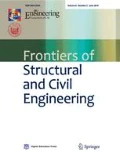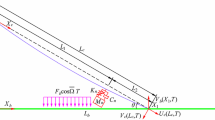Abstract
With the application of the particle damping technology to cable vibration attenuation, the rootless cable damper overcomes the limit in installation height of existing dampers. Damping is achieved through energy dissipation by collisions and friction. In this paper, a coupled multi-body dynamics—discrete element method is proposed to simulate the damping of the damper—cable system under a harmonic excitation. The analyses are done by combining the discrete element method in EDEM and multi-body dynamics in ADAMS. The simulation results demonstrate the damping efficiency of rootless particle damper under different excitations and reveal the influence of the design parameters on its performance, including the filling ratio, particle size, coefficient of restitution, and coefficient of friction.
Similar content being viewed by others
References
Abdel-Ghaffar A M, Khalifa M A. Importance of cable vibration in dynamics of cable-stayed bridges. Journal of Engineering Mechanics, 1991, 117(11): 2571–2589
Dan D, Ge L, Yan X. Identification of moving loads based on the information fusion of weigh-in-motion system and multiple camera machine vision. Measurement, 2019, 144: 155–166
Duan Y F, Ni Y Q, Ko J M. State-derivative feedback control of cable vibration using semiactive magnetorheological dampers. Computer-Aided Civil and Infrastructure Engineering, 2005, 20(6): 431–149
Weber F, Boston C. Energy based optimization of viscous-friction dampers on cables. Smart Materials and Structures, 2010, 19(4): 045025
Li J, Liu Z, Liu Z, Huang L, Zhou C, Liu X, Zhu W. Electromechanical characteristics and numerical simulation of a new smaller magnetorheological fluid damper. Mechanics Research Communications, 2018, 92: 81–86
Pacheco B M, Fujino Y, Sulekh A. Estimation curve for modal damping in stay cables with viscous damper. Journal of Structural Engineering, 1993, 119(6): 1961–1979
Dan D, Gong J, Chen Z, Sun L. CN Patent, CN10316-1124A, 2013–06-19
Luo Z, Yan W, Xu W, Zheng Q, Wang B. Experimental research on the multilayer compartmental particle damper and its application methods on long-period bridge structures. Frontiers of Structural and Civil Engineering, 2019, 13(4): 751–766
Wu W T, Aubry N, Massoudi M. Flow of granular materials modeled as a non-linear fluid. Mechanics Research Communications, 2013, 52: 62–68
Lu Z, Lu X, Jiang H. F. Masri S. Discrete element method simulation and experimental validation of particle damper system. Engineering Computations, 2014, 31(4): 810–823
Cundall P A, Strack O D L. A discrete numerical model for granular assemblies. Geotechnique, 1979, 29(1): 47–65
Ahmad N, Ranganath R, Ghosal A. Modeling and experimental study of a honeycomb beam filled with damping particles. Journal of Sound and Vibration, 2017, 391: 20–34
Hou Y, Wang L. Multiscale mechanical modeling of hydrated cement paste under tensile load using the combined DEM-MD method. Frontiers of Structural and Civil Engineering, 2017, 11(3): 270–278
Zhou Y C, Wright B D, Yang R Y, Xu B H, Yu A B. Rolling friction in the dynamic simulation of sandpile formation. Physica A, 1999, 269(2–4): 536–553
Mindlin R D, Deresiewicz H. Elastic spheres in contact under varying oblique forces. Journal of Applied Mechanics, 1953, 9: 327–344
Sakaguchi H, Ozaki E, Igarashi T. Plugging of the flow of granular materials during the discharge from a silo. International Journal of Modern Physics B, 1993, 7: 1949–1963
Tsuji Y, Tanaka T, Ishida T. Lagrangian numerical simulation of plug flow of cohesionless particles in a horizontal pipe. Powder Technology, 1992, 71(3): 239–250
Weber F, Distl H. Amplitude and frequency independent cable damping of Sutong Bridge and Russky Bridge by magnetorheological dampers. Structural Control and Health Monitoring, 2015, 22(2): 237–254
Mcisaac K A. A hierarchical approach to motion planning with applications to an underwater eel-like robot. Dissertation for the Doctoral Degree. Philadelphia, PA: University of Pennsylvania, 2001
Dan D, Han F, Cheng W, Xu B. Unified modal analysis of complex cable systems via extended dynamic stiffness method and enhanced computation. Structural Control and Health Monitoring, 2019, 26(10): e2435
Han F, Dan D, Cheng W, Zang J. A novel analysis method for damping characteristic of a type of double-beam systems with viscoelastic layer. Applied Mathematical Modelling, 2020, 80: 911–928
Hoang N, Fujino Y. Multi-mode control performance of nonlinear dampers in stay cable vibrations. Structural Control and Health Monitoring: The Official Journal of the International Association for Structural Control and Monitoring and of the European Association for the Control of Structures, 2009, 16(7–8): 860–868
Acknowledgements
This study was supported by the National Natural Science Foundation of China (Grant No. 5187849); National Key R&D Program of China (2017YFF0205605); Shanghai Urban Construction Design Research Institute Project “Bridge Safe Operation Big Data Acquisition Technology and Structure Monitoring System Research”; and Ministry of Transport Construction Science and Technology Project “Medium—Small Span Bridge Structure Network Level Safety Monitoring and Evaluation.”
Author information
Authors and Affiliations
Corresponding author
Rights and permissions
About this article
Cite this article
Dan, D., Wang, Q. & Gong, J. Application of coupled multi-body dynamics—discrete element method for optimization of particle damper for cable vibration attenuation. Front. Struct. Civ. Eng. 15, 244–252 (2021). https://doi.org/10.1007/s11709-021-0696-x
Received:
Accepted:
Published:
Issue Date:
DOI: https://doi.org/10.1007/s11709-021-0696-x



